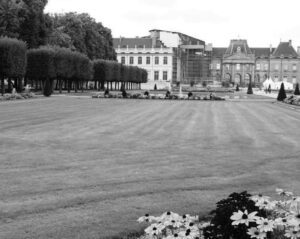
The Château de Lunéville was built in the 13th century and almost destroyed by fire in 2003. It is surrounded by famous gardens, Les Bosquets.
Editor’s Note: At the request of his readers and in memory of Warner M. Montgomery, Ph.D, we will continue to publish his Adventure Travel stories for the time being.
The Verdun battlefield was such a shock that quiet filled Olivier’s car as we drove through the rolling farmland of Lorraine to Lunéville, another historic site. The Château de Lunéville belonged to the Dukes of Lorraine from the 13th century. It was rebuilt as “The Versailles of Lorraine” by Duke Léopold I from 1703 to 1723 and included the famous Les Bosquets (formal gardens with statuary). Napoleon signed a peace treaty in Lunéville with Russia, Britain, Austria, the Ottoman Empire, Portugal, Naples, and the Vatican.
Lunéville was a major center of earthenware and embroidery production but suffered during World Wars I and II. Since 1950 these industries have recovered, and their products are famous worldwide.
Disaster struck in 2003 when much of the château was destroyed by fire. Renovation was still underway when we arrived so we were not able to enter the building. Linda and I walked through the gardens with Olivier and Benedicte. Little Thomas was rolled along in his stroller until we found a nice place for a picnic.
There were many statues and monuments in the garden. At the far end near a closed amusement park was a section dedicated to the French people who were taken by the Nazis to concentration camps.
Huge coffin–like structures were engraved with thousands of names. A reminder of terrible times.
We drove through the town after lunch, and Olivier pointed out historic sites: an Italian–style theater, a medieval merchant’s house built of red stone, and the first synagogue built in France since the 13th century. On the outskirts of town was a stork refuge where the white stork was being reintroduced to the area. About 20 birds were in a large netted area, and many others nested on surrounding buildings.
Our final stop of the day was a wonderful surprise. Benedicte announced it was mirabelle season and we were going to a mirabelle farm.
Mirabelles are small, oval, fleshy, dark yellow plum–like fruit grown only in Lorraine. It is sweet and flavorful and can be eaten right off the tree or made into jam, pie filling, wine, or brandy. The European Union has recognized, qualified, and protected the Lorraine mirabelle.
At the Maison de la Mirabelle, we watched a movie, toured the factory, observed the farmers picking and carting the fruit, and visited the shop. Linda and Benedicte bought jars of jam, bottles of brandy, and bags of fruit. That night, back at Nancy, we taste–tested our newly found fruit. Believe me, all versions of mirabelle are delicious.


Loading Comments